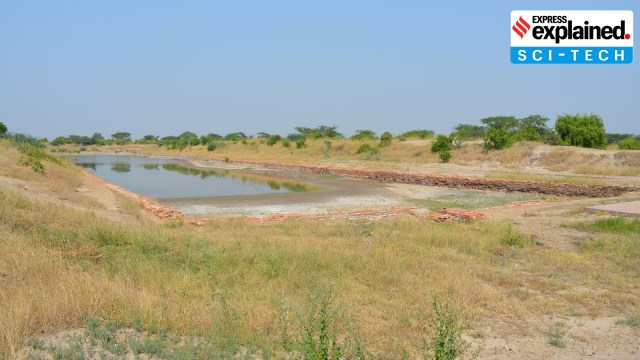New study suggests existence of a dockyard at Lothal, Gujarat, during Harappan Civilisation: What are the findings?
The study has revealed that the Sabarmati river used to flow by Lothal (currently, it flows 20 km away from the location) during the Harappan Civilisation
 The site of the dockyard at Lothal, Gujarat, during the Indus Valley Civilisation. (Wikimedia Commons)
The site of the dockyard at Lothal, Gujarat, during the Indus Valley Civilisation. (Wikimedia Commons)Since the discovery of Harappan sites at Lothal, located in the Bhal region of Gujarat, in the 1950s, archaeologists have been divided on whether a dockyard existed at the location during the Indus Valley Civilisation.
This may now change as a new study by the Indian Institute of Technology-Gandhinagar (IITGn) has found fresh evidence which can confirm the dockyard’s existence. The study has revealed that the Sabarmati river used to flow by Lothal (currently, it flows 20 km away from the location) during the Harappan Civilisation. There was also a travel route connecting Ahmedabad, through Lothal, the Nal Sarovar wetland, and the Little Rann, to Dholavira — another Harappan site, according to analysis.
“Satellite images have unveiled the old channels of the River Sabarmati, suggesting Lothal’s key location on a significant river route linked to Koth [a village in Ahmedabad] and other resource-rich areas on the one hand and Little Rann of Kachchh through the Nal Sarovar on the other. The research supports the dockyard theory and addresses concerns about historical inlets, demonstrating Lothal’s importance for trade via river and sea routes,” according to a statement by the Press Information Bureau (PIB).
The study, ‘Sabarmati and its connection with the Harappan port Lothal and the Nal corridor: A study using multi-sensor data, cloud-computing and multi-platforms’, was published in the Journal of Archaeological Science in August. It has been carried out by Ekta Gupta, V N Prabhakar, and Vikrant Jain of IITGn.
Here is a look at the findings and the techniques used for the study.
What are the findings of the study?
The researchers based their study on the hypothesis that from Lothal, there was an inland network connected to the Rann of Kutch.
When investigating, Gupta identified a water channel which ultimately turned out to be the Sabarmati river. It flowed by Lothal and later shifted to the present-day course — now flowing 20 km from the location, according to the study.
Speaking to The Indian Express, Prabhakar said, “Using the technology we could find a gradual shifting of the Sabarmati river where it reached its present day course. One of these is coinciding with Lothal. So it means when Lothal was there as a Harappan port, definitely this river was flowing at the spot. The Nal Sarovar was in full flow out from which one river came out. So there was a connection from Lothal as one can directly go to the Nal Sarovar and from here to the Little Rann, then on to Dholavira. If one person travels by boat, he can reach there within two days. So this is how the traders might have travelled, transferred goods because, from Lothal, we have got the evidence of foreign trade.”
The study suggests that traders came to Gujarat through the Gulf of Khambhat, probably went to Ratanpura to get materials, and carried them to Mesopotamia (modern-day Iraq).
Those who believed that a dockyard existed at Lothal based their hypothesis on the discovery of a 222 x 37 metres basin at the location. Others, however, argued that it was just an “irrigation tank”.
How was the study carried out?
For their study, the researchers used data from early maps, satellite imagery, and digital elevation models — 3D models that represent the topography of a planet or celestial body.
The researchers particularly focused on two 19th Century topographic maps. They used the maps to distinguish paleochannels — old or ancient river channels — from the perennial streams and understand geomorphic changes that occurred in the past 150 years.
Prabhakar highlighted that studying satellite images helped him and his team save time that would have been spent on ground surveys.
He said that the technology allowed them to “peep anywhere in the world, access remote areas, which are inaccessible to humankind and helped to identify potential spots that can be later verified on ground”.
- 01
- 02
- 03
- 04
- 05






































